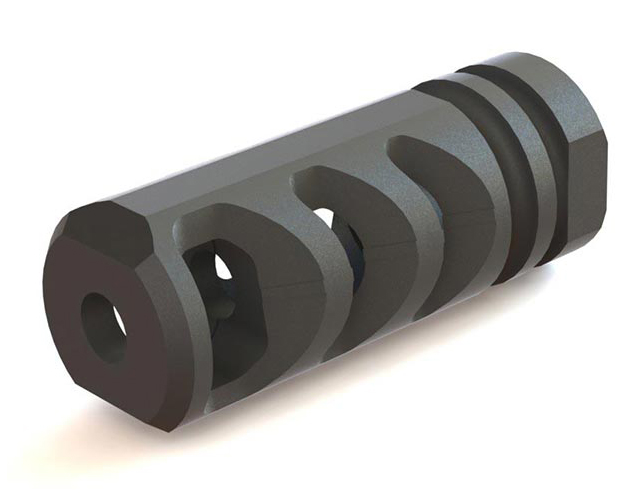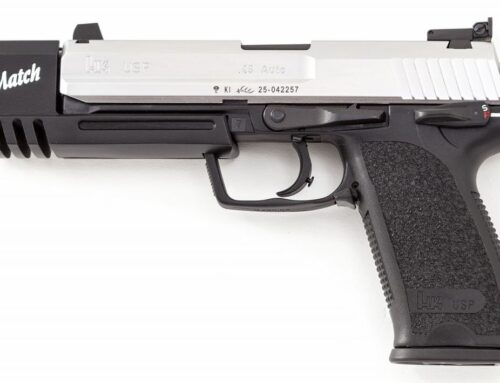In today’s market filled with AR-15’s and every sort of ‘tactical’ firearm platform imaginable there’s a whole slew of associated new buzz words being thrown about. The three being focused on here all refer to muzzle attachments, devices which are all meant to serve an important role with modern firearm designs.
While these three labels are often used interchangeably this is actually not correct, as each one fulfills a specific function. Because these words are so often considered to be synonymous one cannot always rely upon what they’re being marketed as. The easiest way to determine what any given muzzle device is really designed for can generally be accomplished simply by knowing what to look for.
Muzzle Brakes are designed for one purpose, which is to redirect the muzzle energy directly out to the sides or at a backward angle. As the name suggests they are designed as ‘brakes,’ by pushing the energy outward or backward it serves to lessen the felt recoil by using some of the energy from each fired shot to counter-act the recoil impulse. Put simply, when you pull the trigger the gun wants to shove backward while the muzzle brake wants to pull forward. Quite useful, however these can be incredibly loud (and might make your range neighbors a little ornery). Muzzle brakes are easy to spot by the wide openings on the sides of the device.
Compensators work a little differently. The primary role of a compensator is, as suggested, to ‘compensate’ for muzzle climb. These focus some of the energy straight up which in turn pushes the front of the barrel downward with each shot. Quite frequently compensators will also have openings along the side just like a muzzle brake. If the device has any vents or ports along the top then it’s no longer just a muzzle brake, it’s a compensator.
There’s also something on the market called a ‘linear compensator,’ which is rather misleading. These devices redirect all of the muzzle energy directly forward, and a fair amount of the noise with them. This makes them somewhat more handy for indoor range use. However, because all of the energy is going forward that means there is absolutely nothing counteracting felt recoil. One argument is that this channels the energy straight back, which in turn helps to reduce muzzle rise (hence calling it a compensator), though the jury’s still out on this one.
Flash Hiders are something altogether different. Their primary role is to reduce or eliminate as much of the flash as possible when you shoot. During low light conditions a flash signature can be problematic. It can both interrupt your own ability to see and, more importantly, in combat situations they show the enemy exactly where you’re shooting from. Most flash hiders (actual ones built just for this role) do a fantastic job of reducing this flash, however the recoil impulse is often still pretty sharp. By design they often have several symmetrical cuts running the length of the device and sometimes have open tines, looking more like a circular fork than a cylinder.
There is no shortage of muzzle attachment manufacturers who will gleefully tout their products as accomplishing all three of these tasks, but there are some things to consider here. By trying to do all three they are limiting their effectiveness within each role. A compensator may kick back a little more than a muzzle brake despite the barrel not jumping upward as much because it’s dividing that energy across two different tasks.
Similarly, brakes and compensators don’t care about a major flash signature. In fact, they often amplify it! Many manufacturers have tried to harness this proverbial fireworks display to make a firearm look more aggressive. As you can imagine, this would make a flash hider’s job that much more difficult!
With all of this in mind, which is the best? Unless you’re going into combat or competitive shooting then it probably doesn’t matter all that much for the average shooter. It may help to consider a muzzle device as a means of fine-tuning your firearm rather than the end-all be-all component.
If your rifle blinds you when you shoot it, try a flash hider.
If your rifle has a harsh recoil, try a muzzle brake (or a compensator.)
If your rifle kicks so hard that you spend more time staring at the sky than the target, try a compensator.
If your rifle is excessively loud and a suppressor isn’t an option, maybe try a linear compensator.
One final detail to consider, not all of these devices are legal in every state.








